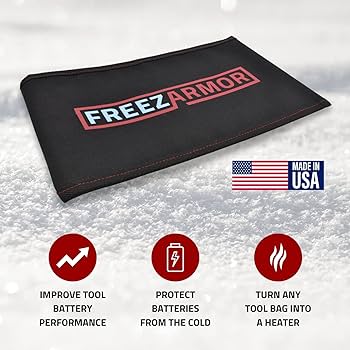To maintain cordless tool performance in extreme weather conditions, it is crucial to follow proper care and handling practices. Inadequate protection can lead to damage, reduced efficiency, and shortened lifespan.
Take necessary precautions such as storing tools in a climate-controlled environment, using battery cases or bags, and avoiding exposure to excessive heat or cold. Regularly inspect and clean tools, ensuring that batteries are charged and stored properly. Remember to follow manufacturer’s guidelines for maintenance and usage.
By implementing these best practices, you can optimize the performance and longevity of your cordless tools in any weather condition.
Understanding The Impact Of Extreme Weather On Cordless Tools
Extreme weather conditions can have a significant impact on the performance of cordless tools. When exposed to extreme temperatures, these tools can experience various issues. High temperatures can lead to overheating of the battery, causing reduced power output and shorter battery life. On the other hand, freezing temperatures can cause the battery to lose efficiency and capacity. Humidity is another factor to consider, as it can promote corrosion and rust on the tool’s metal surfaces. It is crucial to keep cordless tools in dry and climate-controlled environments when not in use to mitigate the effects of high humidity. Precipitation, including rain and snow, can infiltrate the tool’s components and cause damage or electrical shorts. Therefore, it is essential to protect tools from exposure to moisture and ensure proper drying if they get wet. By being aware of these effects, users can adopt preventive measures to maintain the performance and longevity of their cordless tools.
Choosing The Right Tools For Extreme Weather Conditions
Choosing the right cordless tools for extreme weather conditions is essential to ensure optimal performance and durability. There are factors to consider when selecting these tools. First and foremost, weather resistance should be a top priority. Look for tools that are specifically designed to withstand extreme temperatures, high humidity, and other challenging weather conditions. This includes water-resistant or waterproof features, as well as dust and debris protection. Additionally, consider the battery life and power output of the tools, as these can be affected by weather conditions. Some tools also come with specific cold weather features, such as anti-freeze protection or insulated handles.
When it comes to brands and models that excel in extreme weather, there are several options to consider. Brand X offers a range of durable, weather-resistant tools that are known for their reliability in harsh conditions. Model Y from Brand Z is another popular choice, with its robust construction and high performance. For extreme cold weather, Model A from Brand B is recommended, thanks to its specially designed features for sub-zero temperatures. Ultimately, the best choice will depend on your specific needs and the weather conditions you anticipate.
Preparing Cordless Tools For Extreme Weather
Preparing Cordless Tools for Extreme Weather: When it comes to maintaining cordless tool performance in extreme weather conditions, proper tool storage and maintenance are crucial.
Proper tool storage and maintenance: Keeping cordless tools in a clean and dry environment is essential. Store them in a tool bag or case to protect them from dust, moisture, and other elements. Additionally, use silica gel packs or moisture-absorbing packets to prevent any humidity-related damage.
Battery care and management in extreme temperatures: Extreme temperatures can negatively affect battery performance. To ensure optimum performance, keep batteries in a cool and dry place when not in use. Avoid exposing them to high or low temperatures for extended periods. Regularly inspect and clean battery contacts to maintain proper electrical connection.
Accessories and attachments for weather protection: Investing in weather-resistant accessories and attachments can help protect cordless tools in extreme weather conditions. These include rain covers, thermal wraps, and tool sleeves. These protective measures can extend the lifespan of your tools and prevent any potential damage caused by extreme temperatures or precipitation.
Techniques To Enhance Cordless Tool Performance In Extreme Weather
Extreme weather conditions can significantly impact the performance of cordless tools. In cold conditions, it is essential to keep the tools warm to maintain their functionality. Storing the tools indoors or using insulated storage containers can help protect them from the cold. Additionally, using battery warmers or heated tool boxes can prevent batteries from draining too quickly and ensure optimal performance.
On the other hand, in hot climates, the risk of tool overheating is a concern. Using cooling mats or fans can help dissipate heat and prevent the tools from becoming too hot. Regularly cleaning the tools from dust and debris can also improve airflow and prevent overheating.
High humidity environments can pose challenges too, as moisture can damage the tools. Storing tools in dry, well-ventilated areas and using moisture-absorbing packs can help mitigate the effects of humidity. It is also crucial to regularly inspect and clean the tools to prevent any corrosion or rust.
By implementing these best practices, users can ensure that their cordless tools perform optimally in extreme weather conditions, enhancing their longevity and efficiency.
Best Practices For Using Cordless Tools In Extreme Weather
Using appropriate safety gear in extreme weather conditions: When working with cordless tools in extreme weather conditions, it is essential to prioritize safety by using appropriate protective gear. This includes wearing gloves, safety goggles, and insulated clothing to protect against extreme cold or heat. Additionally, using insulated tool handles can help prevent electrical shock in wet or humid conditions.
- Check the manufacturer’s guidelines: Always refer to the manufacturer’s guidelines for proper operation and maintenance of your cordless tools in extreme weather conditions.
- Battery maintenance: Extreme temperatures can impact battery performance. Store batteries in a cool, dry place and avoid exposing them to direct sunlight or extreme cold.
- Regular cleaning and inspection: Clean your tools regularly and inspect for any signs of damage caused by weather conditions. Replace worn-out parts promptly.
- Keep tools dry: Moisture can damage cordless tools. Store them in waterproof cases or use covers to protect them when not in use.
- Proper storage: When not in use, store your cordless tools in a safe place away from extreme temperatures and humidity.
- Survey the work area: Before starting any project, assess the workspace for potential hazards such as slippery surfaces, ice, or strong winds. Remove any obstacles or debris that may pose a risk.
- Secure workpieces: In extreme weather conditions, strong gusts of wind or heavy rain can displace materials. Make sure to secure workpieces properly to prevent accidents.
- Use stable platforms: When working with cordless tools at heights, ensure stable platforms or scaffolding are used and that they are properly secured. Avoid working alone in extreme weather scenarios.
- Monitor weather conditions: Stay updated on weather forecasts and avoid working in severe weather conditions when possible. It is important to prioritize personal safety above all else.

Credit: nextracker.com
Troubleshooting Common Issues In Extreme Weather
Maintaining cordless tool performance in extreme weather conditions can be challenging. This article provides best practices for troubleshooting common issues and ensuring optimal functionality in harsh climates.
Identifying Symptoms Of Tool Malfunction In Extreme Conditions
Extreme weather conditions can negatively impact the performance of cordless tools. To ensure smooth operation, it is important to identify potential symptoms of tool malfunction. Look out for decreased power output, abnormal or erratic motor behavior, or frequent overheating. These could indicate issues with the tool’s internal components or battery.
Diagnosing And Fixing Battery-related Issues
Battery problems often arise in extreme weather conditions. Intermittent power supply, rapid battery drain, or slow charging are common signs of battery-related issues. It is essential to check the battery’s condition regularly, ensure proper contact with the tool, and store it in a controlled environment when not in use. Cleaning battery terminals and replacing damaged or worn-out batteries can significantly improve cordless tool performance in extreme weather.
Handling Tool Damage Caused By Weather Exposure
Exposure to extreme weather can lead to tool damage. Moisture or water ingress, rust formation, or corrosion can significantly affect the tool’s functionality. Protecting cordless tools from adverse weather conditions through proper storage, use of protective covers, or waterproof cases is crucial in maintaining their performance. Regular inspection, cleaning, and lubrication of tool components can help prevent weather-induced damage. Addressing any visible signs of wear or tear promptly can extend the lifespan of cordless tools and ensure optimum performance in extreme weather.
Tool Maintenance For Longevity In Extreme Weather
The performance and longevity of cordless tools can be significantly affected by extreme weather conditions. To ensure their optimal functioning, it is crucial to follow certain best practices for tool maintenance. This includes thorough cleaning and proper storage after use in extreme conditions. Removing dirt, debris, and moisture from the tools will help prevent any damage and increase their lifespan. Additionally, performing periodic inspections will allow you to identify any issues early on and take necessary actions. By following these best practices, you can effectively extend the lifespan of your cordless tools, even in harsh weather conditions. Remember to refer to your tool’s specific user manual for any manufacturer-recommended maintenance instructions to ensure maximum performance and durability.
Table: Tool Maintenance Checklist for Extreme Weather Conditions
| Step | Description |
|---|---|
| 1 | Clean the tools thoroughly after use |
| 2 | Inspect for any signs of damage or wear |
| 3 | Remove any dirt, debris, or moisture |
| 4 | Store in a dry and temperature-controlled environment |
| 5 | Check and tighten any loose parts |
| 6 | Refer to the user manual for specific maintenance instructions |
Frequently Asked Questions Of What Are The Best Practices For Maintaining Cordless Tool Performance In Extreme Weather Conditions?
What Are The Best Practices For Maintaining Cordless Tool Performance?
To maintain cordless tool performance, clean the tool regularly, ensure proper storage, use compatible batteries and chargers, and follow manufacturer guidelines for maintenance and repairs.
How Can Extreme Weather Conditions Affect Cordless Tool Performance?
Extreme weather conditions, such as high heat or extreme cold, can affect battery performance and tool functionality. Batteries may drain faster or not perform optimally in extreme temperatures, and tool components may expand or contract, leading to decreased performance or even damage.
How Should Cordless Tools Be Stored During Extreme Weather Conditions?
During extreme weather conditions, it’s best to store cordless tools in a temperature-controlled environment, away from direct sunlight or excessive moisture. Ensure that the tools are protected from extreme heat, cold, or humidity to prevent damage to batteries and internal components.
What Precautions Should Be Taken When Using Cordless Tools In Extreme Weather?
When using cordless tools in extreme weather, avoid exposing them to direct sunlight for extended periods. Allow tools to acclimate to the temperature before use, and monitor battery performance closely. If the tool or battery feels unusually hot or shows signs of malfunction, stop using it immediately and seek professional assistance.
Conclusion
To ensure optimal performance of your cordless tools in extreme weather conditions, it is crucial to follow a few best practices. Remember to store them in a cool, dry environment and protect them from direct sunlight and excessive moisture. Regularly clean and inspect the tools for any signs of damage.
Don’t forget to charge and maintain the batteries properly. By implementing these practices, you can extend the lifespan of your cordless tools and maximize their performance, even in harsh weather conditions.

